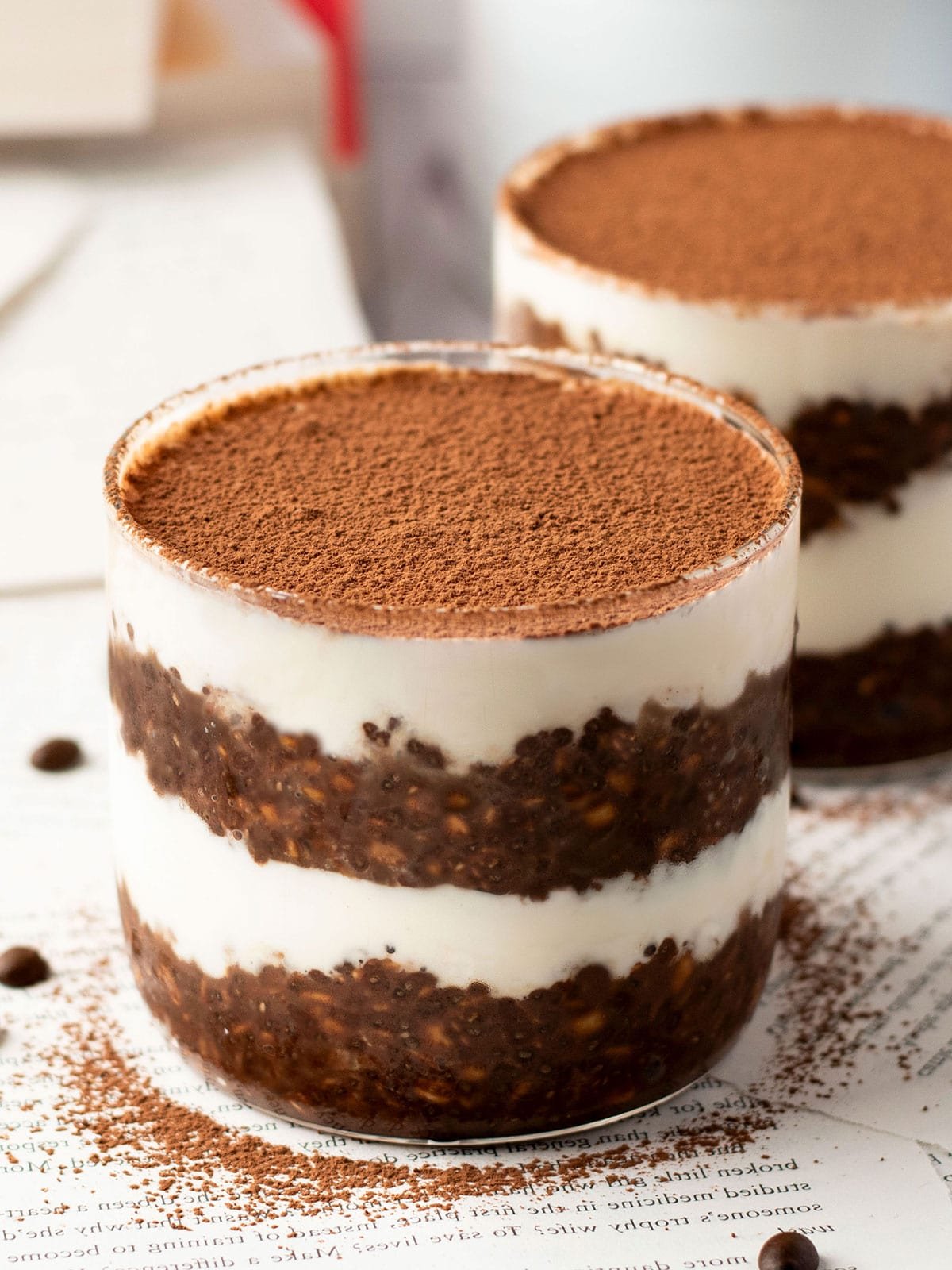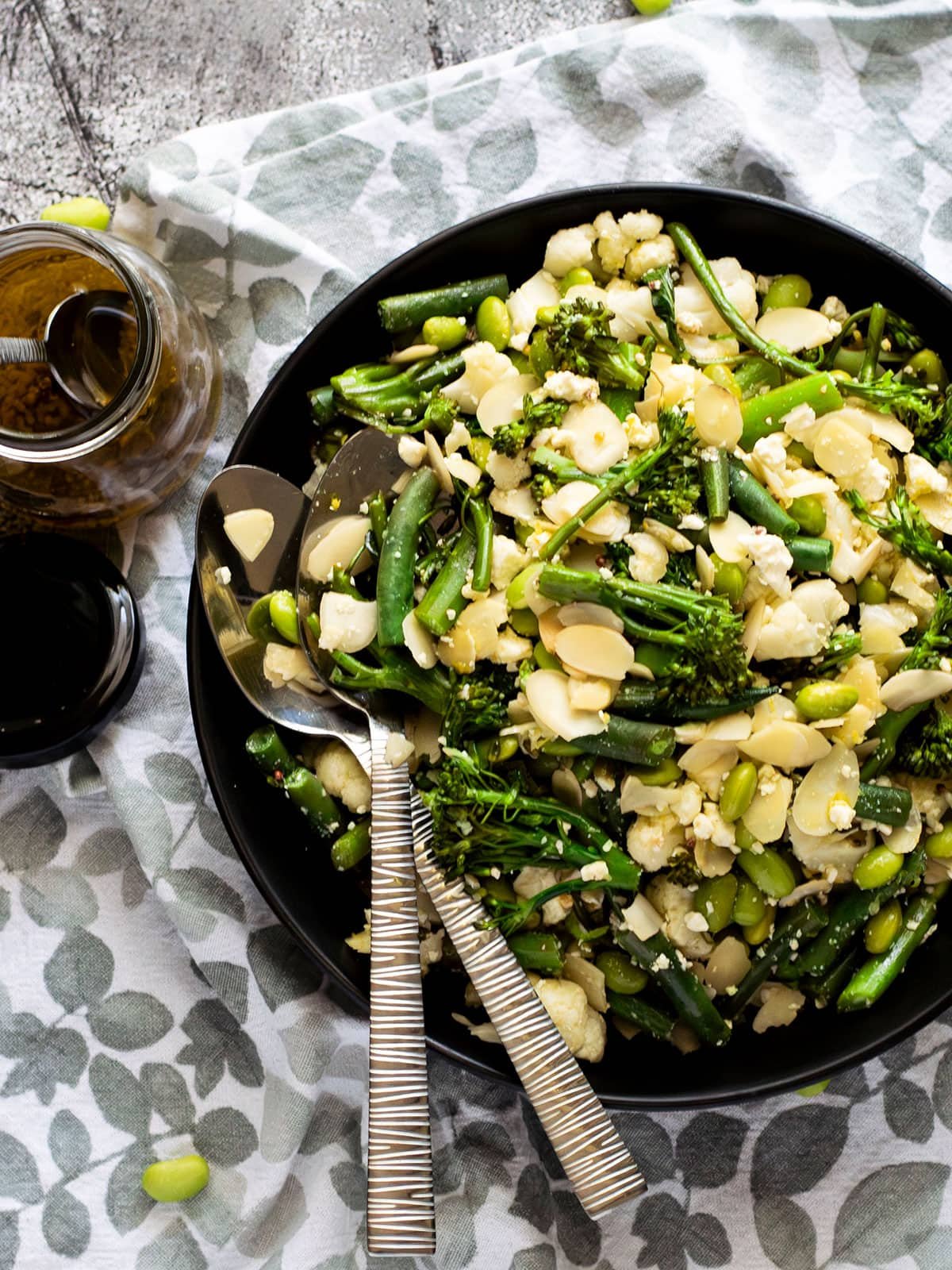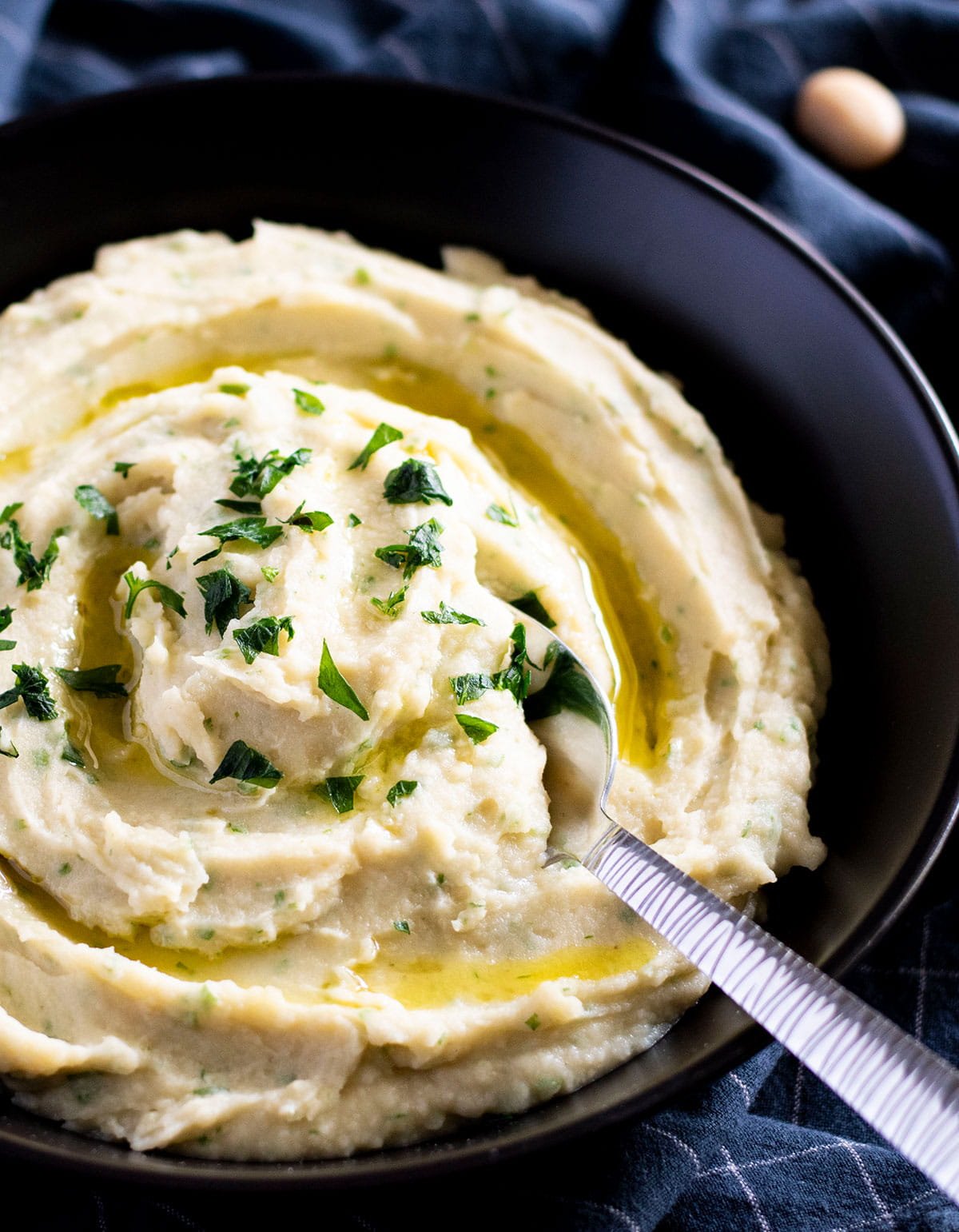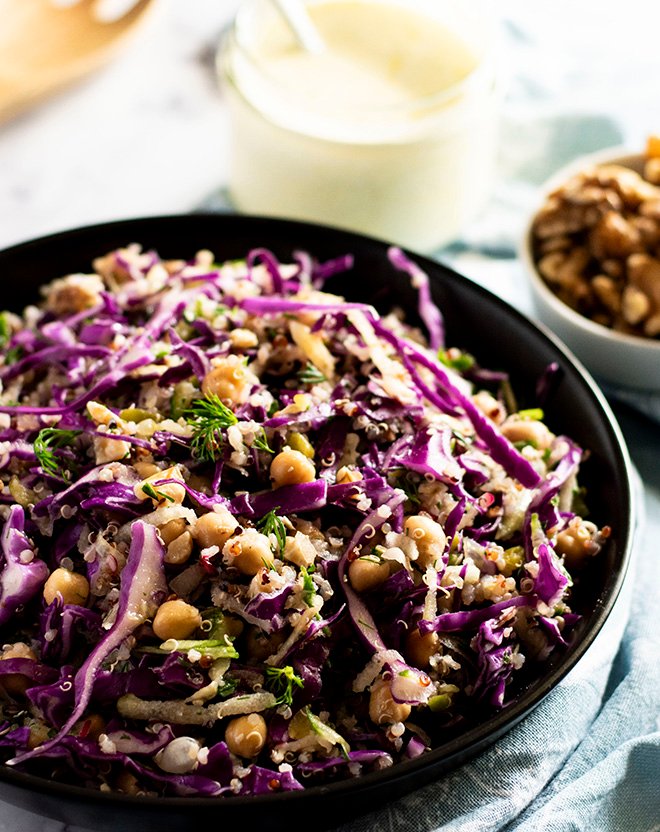Pan Fried Pork Steaks with Balsamic Glaze
These pan fried Pork Steaks with Balsamic Glaze are a great, super quick and easy mid-week dinner solution. Perfectly seared pork with a golden crust, smothered in a balsamic glaze that is sweet and tangy, topped with a sprinkle of crumbled fetta cheese.
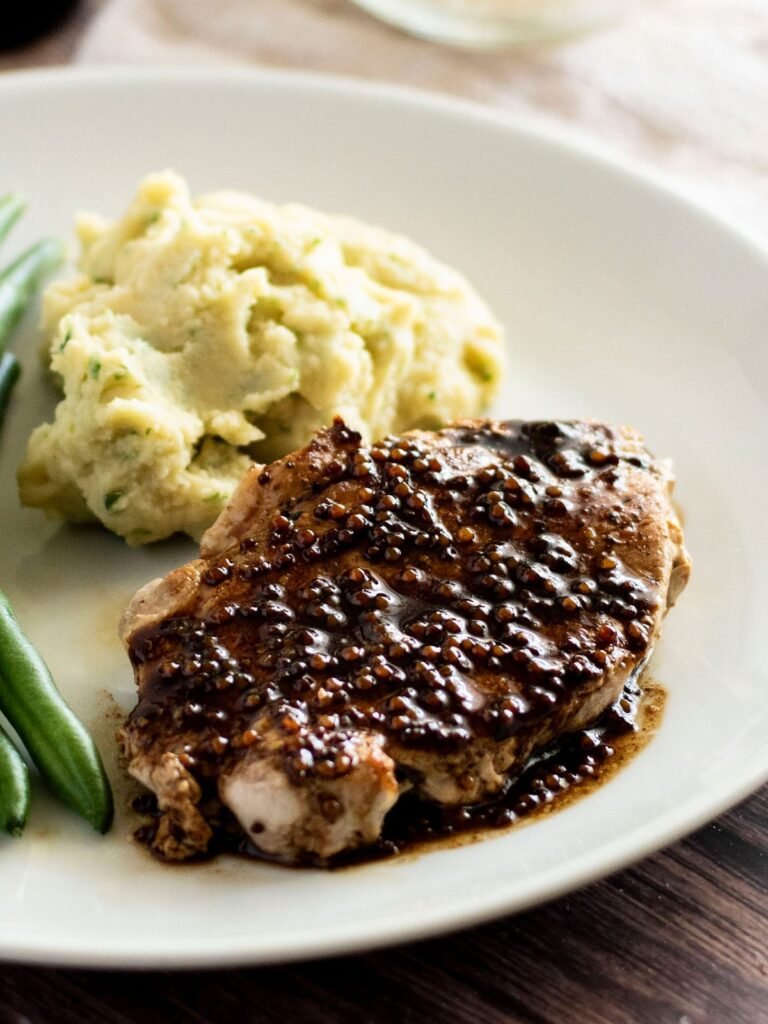
It is no secret that pork and balsamic vinegar pair together beautifully. These Pork Steaks with Balsamic Glaze are a regular in my dinner rotation, as they are quick, simple and pack a punch in flavour. The balsamic reduction is rich, but perfectly balanced with wholegrain mustard and maple syrup. Paired with tender pan seared pork steaks and fetta cheese, it is just a match made in heaven.
Why this is the best Pork Steaks recipe
- Delivers BIG flavours!
- It is versatile – as this balsamic reduction can lend itself to many dishes.
- It is super quick and easy to make!
- Uses only one pan – so less clean up!
- Uses everyday ingredients that you’ll easily find in a supermarket.
- It’s budget friendly – at AUD$13.55 (~USD$8.85) without specials/shopping around.
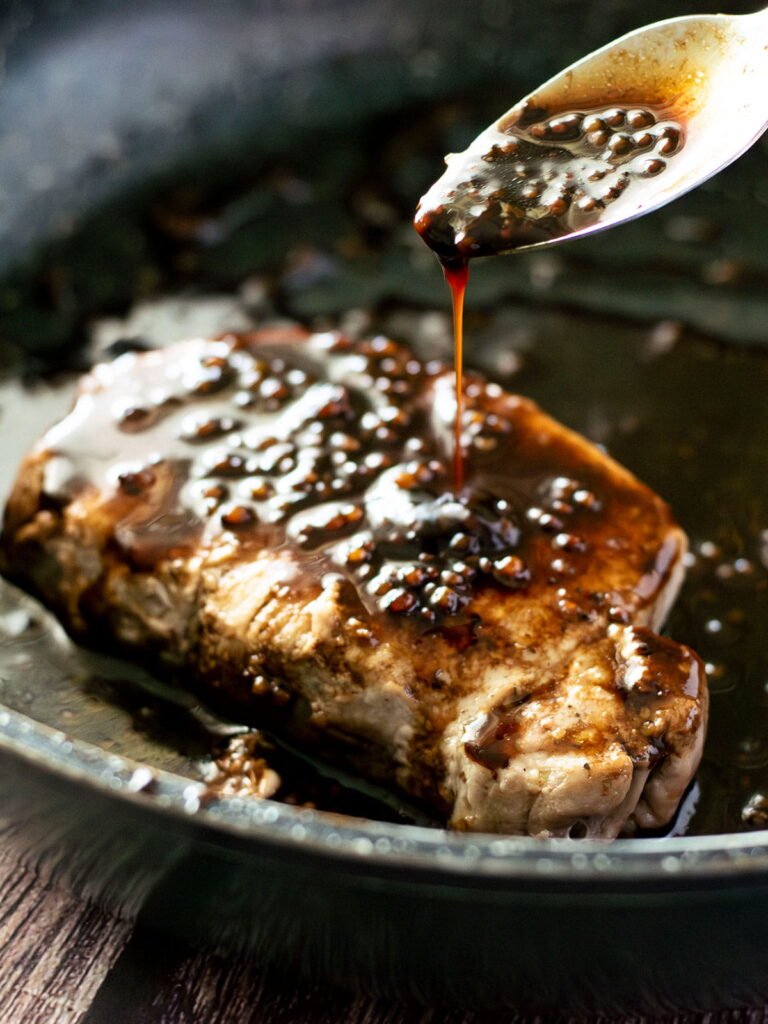
Benefits of Pork
Pork contains a wide variety of nutrients, such as:
- Is a wonderful source of protein, which is important for cell growth, building and repairing our muscles, and maintaining a strong immune system.
- Unlike other meats, pork is a rich source of vitamin B1 (thiamine), which our bodies use to break down the food we eat into energy (our fuel), as well as cell growth, development and function.
- It contains vitamin B3 (niacin), which is important for the metabolism of fat, glucose, and the development and function of body cells.
- Has a good amount of selenium, which doubles as an antioxidant to protect our cells from damage caused by free radicals and helps with thyroid gland function and regulation of thyroid hormones.
- It also contains zinc, which is involved in many enzyme reactions, the storing and releasing of insulin, maintaining a healthy immune system, and tastebud function.
It is important to remember that high intakes of meat (particularly red meat) are associated with an increased risk of cardiovascular disease. However, lean pork can be a great option to include as part of a healthy, balanced diet.
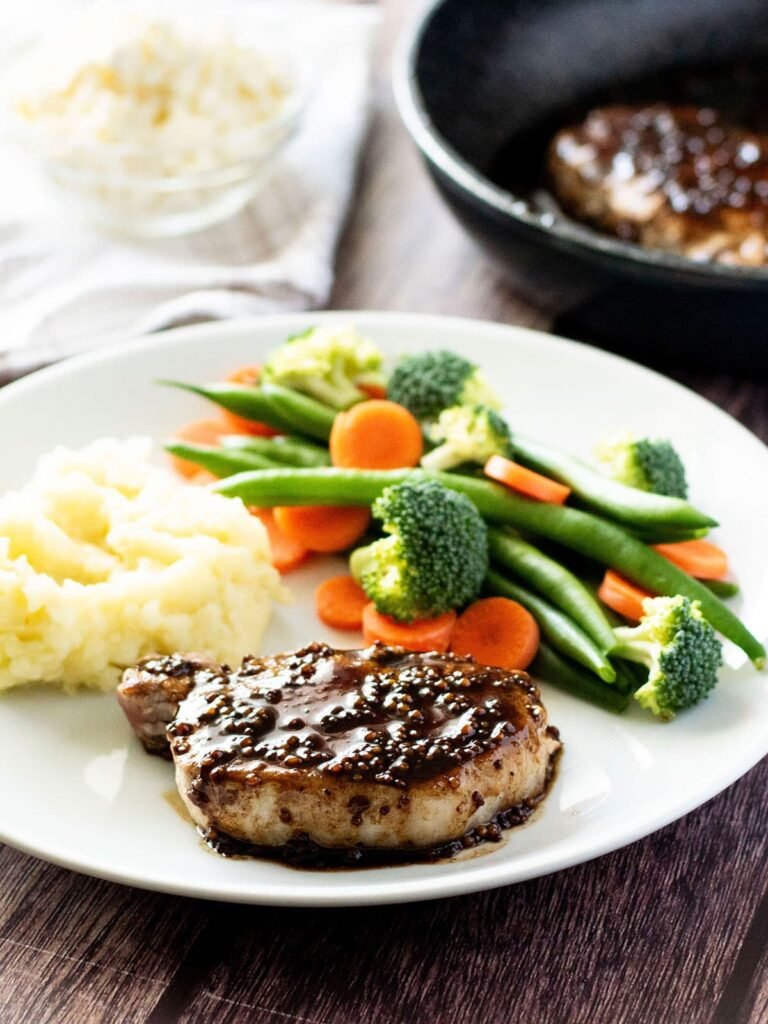
Recipe suitability
These Pork Steaks with Balsamic Glaze are high in protein, with almost 30g per serve. On their own, they are not low in fat or cholesterol. They are, however, low in saturated fat and sodium. However, when paired with a large serving of veggies, these pork steaks can also be low cholesterol and heart friendly. This recipe also uses low GI ingredients and has under 15g of carbohydrates on its own, making it diabetes friendly. It is also gluten-free.
Ingredients for Pork Steaks with Balsamic Glaze
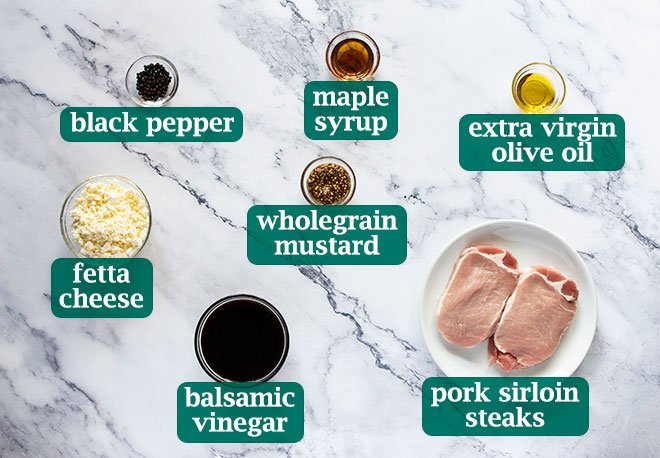
- Pork sirloin steaks – Scroll up to read about the benefits of pork. The steaks I used are ~125g / 4.4 oz each, which are a great size for a single serving.
- Black pepper – For seasoning the pork steaks.
- Balsamic vinegar – Forms the base of the reduction. This may surprise you, but Balsamic vinegar also contains antioxidants, as it is made from grapes. Antioxidants help neutralise free radicals, which are unstable molecules that can build up and harm our cells.
- Wholegrain mustard – Can be very high in excess sodium. Choose a mustard with “no added/reduced salt” or the lowest sodium per 100g where possible. I used “Your Condiment Co.” wholegrain mustard, which you can get at Woolworths.
- Maple syrup – Adds just a touch of sweetness to balance out the pungent balsamic vinegar. Maple syrup does contain quite a bit of sugar, so it is best eaten in moderation.
- Extra virgin olive oil – A great healthy fat for cooking the pork. Extra virgin olive oil contains vitamin E and oleocanthal, which have antioxidant properties. Vitamin E also helps maintain a strong immune system, promotes the widening of blood vessels, and prevents unnecessary blood clots.
- Fetta cheese – Preferably low/reduced fat. I used the Australian reduced-fat feta, which is available from both Coles and Woolworths. Fetta contains a good amount of calcium and phosphorus, which are needed to maintain strong and healthy bones.
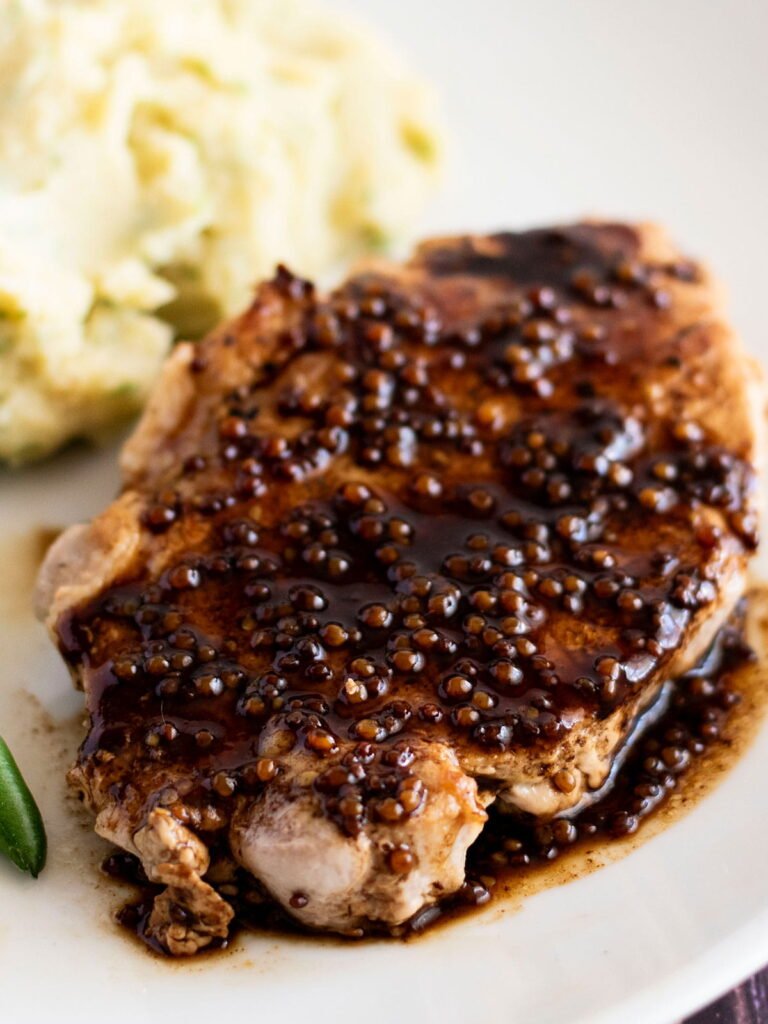
Pork steaks vs pork loin chops
The area where a cut of meat comes from can affect the amount of fat it contains.
- Pork sirloin steaks – Are usually leaner than loin/rib chops, have no bones and are best when cooked quickly, such as grilling or pan frying. In Australia, sirloin steaks are generally leaner than loin chips. Also, check the underside if possible to ensure there are no hidden large chunks of fat in the steak (I had this happen once!). They also seem to go on special quite often at Coles!
- Pork loin chops – While loin chops are lean and more tender, they can have a bit more fat on them than sirloin steaks. They are also good for grilling or pan frying. In Australia, they tend to come with bones and a thick streak of fat on one side.
- Other cuts that would work for this recipe include pork scotch fillet and medallions.
Choose a cut with the least amount of fat, or remove the fat before cooking to reduce the amount of saturated fat in the dish.
How to make Pork Steaks with Balsamic Glaze
In my opinion, the best way to cook pork steaks is pan fried on the stovetop. It is much quicker, you get that nice golden crust and extra flavour by making the balsamic reduction in the same pan!
- Add the balsamic vinegar, wholegrain mustard, and maple syrup in a small bowl. Stir well to mix.
- Season the pork sirloin steaks on both sides with cracked black pepper.

- Heat the extra virgin olive oil in a large skillet/frying pan over medium-high heat. Once the skillet is hot, sear and pan fry the pork steaks on the first side for 3 or until they have developed a dark golden crust. Turn the steaks over and cook for another 3 minutes.

- Transfer the pork steaks to a plate and cover them with foil. Make sure the foil is folded under the plate to trap the heat. This will allow the pork steaks to rest and cook a little bit more without drying out.

- Give the balsamic vinegar mix a quick stir and pour it into to the skillet. When the balsamic vinegar starts to simmer, reduce the heat to medium so it bubbles gently. Important: Do not stand over the frying pan when cooking the balsamic vinegar, as inhaling the fumes makes it difficult to breathe! Make sure you have your range hood/fume extractor on or have a window open nearby.
- Simmer the balsamic vinegar mix for 6-8 minutes, stirring occasionally, or until it reduces roughly by half and has become slightly thickened and glossy. Remove the foil from the pork steaks and add them (and their juices) back to the skillet. Simmer the pork steaks on each side for 20-30 seconds or until they are reheated and coated in the balsamic reduction.

- Serve the pork steaks while hot, smothered with a large spoonful of the balsamic reduction, crumbled fetta cheese and your favourite veggie sides.
Other ways to make Pork Steaks with Balsamic Glaze
BBQ/GRILL
Heat your bbq grill to medium-high. Grease the grates of the BBQ/Grill with oil. Cook the pork steaks for 3 1/2 minutes per side. However, the balsamic reduction will still need to be made on the stove (so it is best made ahead). Served the pork steaks while hot and drizzle with the balsamic reduction.
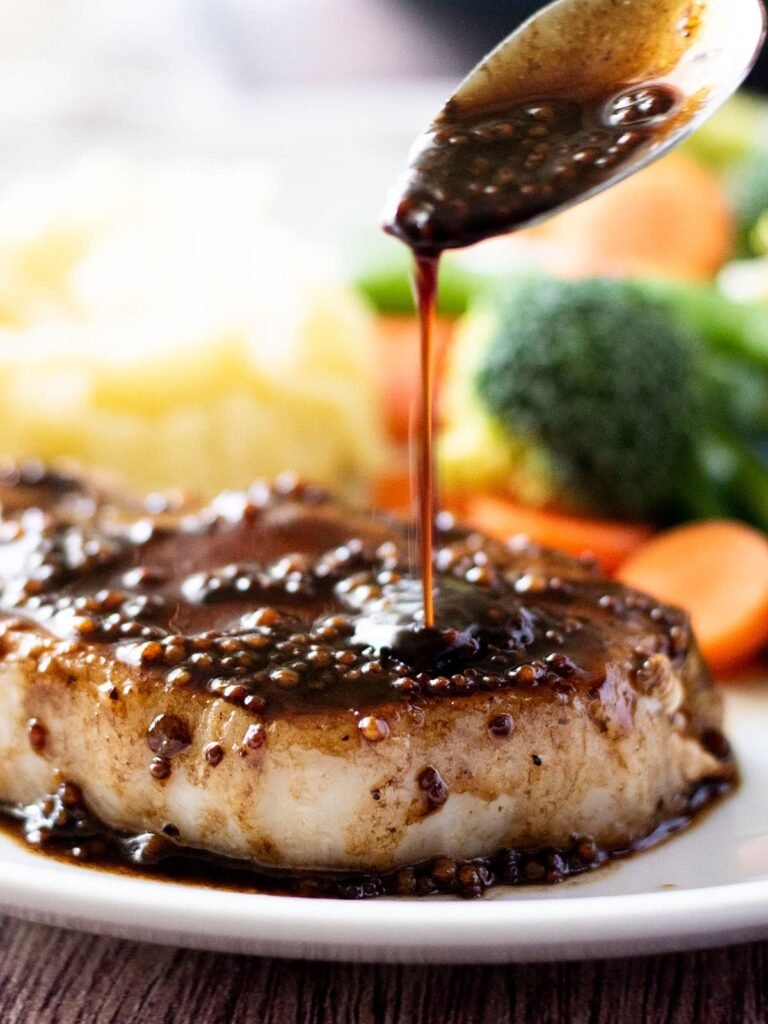
Internal temperature for pork
Unlike beef, pork should never be served rare.
According to FDA, all pork steaks and chops should be cooked to a minimum internal temperature of ~63°C/145°F (as measured with a food thermometer) before removing it from the heat source. The meat should be rested for 3 minutes.
Storage
These pork steaks will last in the fridge in an airtight container for up to 3 days, whereas the balsamic reduction should last up to 1 week.
You can freeze the pork steaks once cooked and should last up to 3 months in the freezer. I do not recommend freezing the balsamic reduction, as it will become watery once defrosted, which will affect its flavour.
To reheat, allow your steaks to come to room temperature, then heat in the oven (covered with foil to retain moisture) at 160°C/320°F for 5-8 minutes or until hot. Microwaving the pork steaks will make them tough and rubbery.
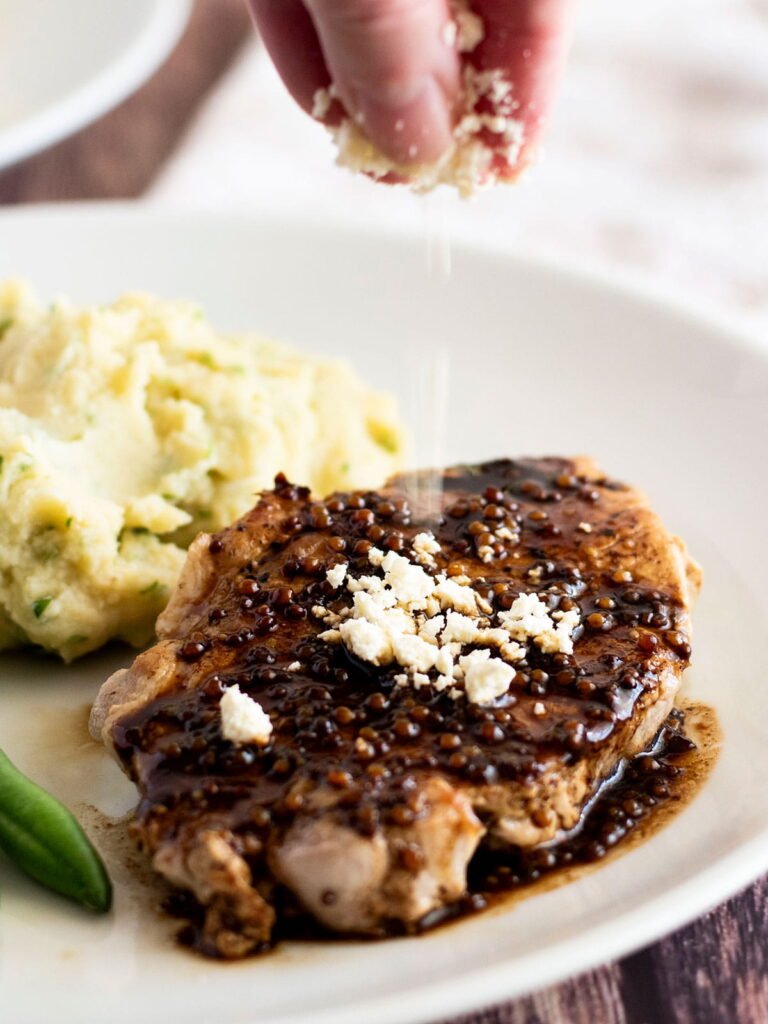
Serve with
Here are some sides I think would go great with these pork steaks:
- Rrich and creamy potato and white bean mash
- Rrefreshing cannellini bean salad
- Crunchy and tangy dill, apple and red cabbage slaw
- Super tasty warm broccolini salad
Other ways to use the Balsamic reduction
Balsamic reduction (balsamic glaze) is a very versatile ingredient, and would pair beautifully with:
- A strong, bitey cheese like a vintage or smoked cheddar with wholegrain crackers
- Roast vegetable and cheese pizza
- A classic bruschetta or caprese salad
Substitutes & variations
The balsamic reduction for this recipe can be used for just about any meat or grilled vegetables. However, I do not think it would go well with seafood.
Other additions to the balsamic glaze:
- Garlic – Freshly minced and sauteed before adding the balsamic vinegar.
- Onions – Thinly sliced and sauteed before adding the balsamic vinegar.
- Thyme – Add to the balsamic mix and stir before pouring it into the skillet.
- Honey – Can be used in place of maple syrup, but it has more sugar and will not be as thick when reduced.
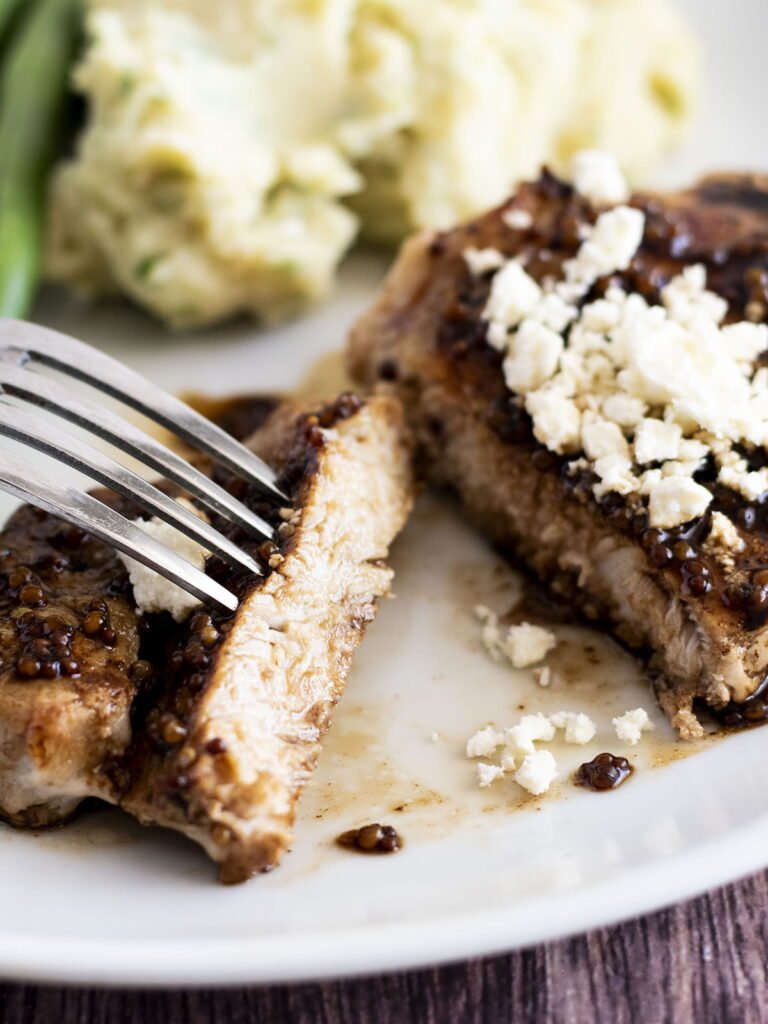
Other dietary
- Gluten free – Always double-check your mustard for any hidden gluten-containing ingredients or warnings of cross contamination during manufacturing.
Tips
If you have time available, let your pork steaks come to room temperature before cooking. This should only take about 20 minutes and helps the steaks to cook more evenly.
Make sure that your skillet is sizzling hot before adding the pork. Otherwise, the pork steaks will not get that nice golden crust like when pan seared.
For steaks that are roughly 1/2 inch thick (which is what I used), stick to cooking for 3 minutes per side. For thicker/larger steaks or pork loin chops, cook for the 3 1/2 – 4 minutes. Otherwise, flatten your thicker pork steaks with a meat mallet/rolling pin to 1/2 inch so they all cook evenly.
Always allow the pork steaks to rest. This lets the juices inside settle without drying out.
Hungry for more?
Don’t forget to subscribe to my newsletter and follow along on Facebook, Instagram and Pinterest for all the latest updates!
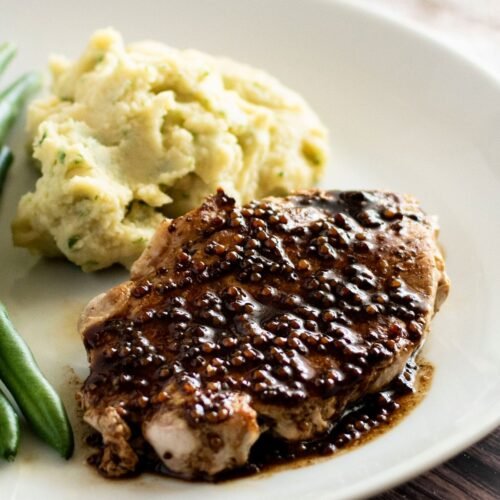
Tap or hover to scale
Ingredients
- 2 pork sirloin steaks, ~125g / 4.4 oz each (Note 3)
- 1/2 cup balsamic vinegar
- 2 tsp wholegrain mustard, preferably low sodium (Note 4)
- 1 tsp maple syrup
- 1/4 cup fetta cheese, low fat & crumbled to serve
Instructions
- Add the balsamic vinegar, wholegrain mustard, and maple syrup in a small bowl. Stir well to mix.
- Season the pork sirloin steaks on both sides with cracked black pepper.
- Heat the extra virgin olive oil in a large skillet/frying pan over medium-high heat. Once the skillet is hot, sear the pork steaks on the first side for 3 minutes or until they have developed a dark golden crust. Turn the steaks over and cook for another 3 minutes. (Note 5)
- Transfer the pork steaks to a plate and cover them with foil. Make sure the foil is folded under the plate to trap the heat. This will allow the pork steaks to rest and cook a little bit more without drying out.
- Give the balsamic vinegar mix a quick stir and pour it into to the skillet. When the balsamic vinegar starts to simmer, reduce the heat to medium so it bubbles gently. Important: Do not stand over the frying pan when cooking the balsamic vinegar, as inhaling the fumes makes it difficult to breathe! Make sure you have your range hood/fume extractor on or have a window open nearby.
- Simmer the balsamic vinegar mix for 6-8 minutes, stirring occasionally, or until it reduces roughly by half and has become slightly thickened and glossy. Remove the foil from the pork steaks and add them (and their juices) back to the skillet. Simmer the pork steaks on each side for 20-30 seconds or until they are reheated and coated in the balsamic reduction.
- Serve the pork steaks while hot, smothered with a large spoonful of the balsamic reduction, crumbled fetta cheese and your favourite veggie sides.
Notes
- Health benefits – Details regarding the benefits of pork and other ingredients in this recipe are in the post above.
- Other cooking methods & instructions with photos – Detailed in the post above.
- Pork sirloin steaks – Can be substituted for pork loin chops. Other cuts that would work for this recipe include pork scotch fillet and medallions.
- Wholegrain mustard – Can be very high in excess sodium. Choose a mustard with “no added/reduced salt” or the lowest sodium per 100g where possible. I used “Your Condiment Co.” wholegrain mustard, which you can get at Woolworths.
- Cooking time – For steaks that are roughly 1/2 inch thick, stick to cooking for 3 minutes per side. For thicker steaks or pork chops, cook for 3 ½ – 4 minutes. Otherwise, flatten your thicker pork steaks with a meat mallet/rolling pin to 1/2 inch so they all cook evenly.
- Storage – Will last in the fridge in an airtight container for up to 3 days, whereas the balsamic reduction should last up to 1 week. The pork steaks can be frozen once cooked and should last up to 3 months in the freezer. I do not recommend freezing the balsamic reduction, as it will become watery once defrosted, which will affect its flavour.
- Nutrition – Calculated per serve, assuming 4 serves with no sides.


